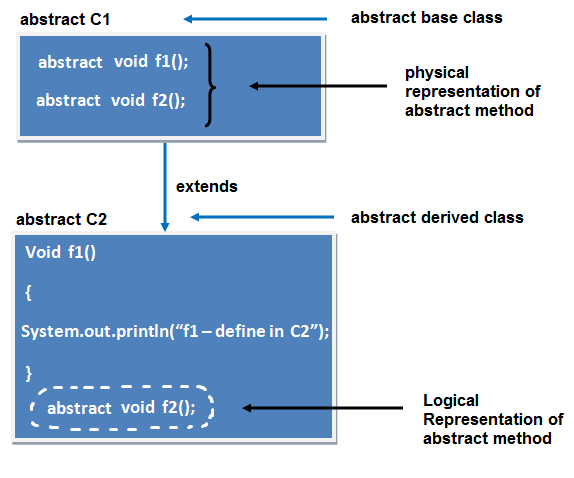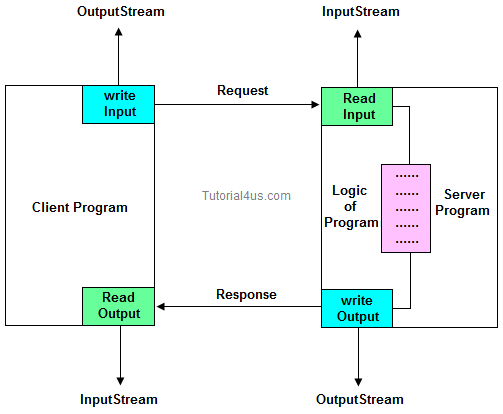Abstract class in Java
We know that every Java program must start with a concept of class that is without the class concept there is no Java program perfect.
In Java programming we have two types of classes they are
- Concrete class
- Abstract class
Concrete class in Java
A concrete class is one which is containing fully defined methods or implemented method.
Example
class Helloworld
{
void display()
{
System.out.println("Good Morning........");
}
}
Here Helloworld class is containing a defined method and object can be created directly.
Create an object
Helloworld obj=new Helloworld();
obj.display();
Every concrete class has specific features and these classes are used for specific requirement, but not for common requirement.
If we use concrete classes for fulfill common requirements than such application will get the following limitations.
- Application will take more amount of memory space (main memory).
- Application execution time is more.
- Application performance is decreased.
To overcome above limitation you can use abstract class.
Abstract class in Java
A class that is declared with abstract keyword, is known as abstract class. An abstract class is one which is containing some defined method and some undefined method. In java programming undefined methods are known as un-Implemented, or abstract method.

Syntax
abstract class className
{
......
}
Example
abstract class A
{
.....
}
If any class have any abstract method then that class become an abstract class.
Example
class Vachile
{
abstract void Bike();
}
Class Vachile is become an abstract class because it have abstract Bike() method.
Make class as abstract class
To make the class as abstract class, whose definition must be preceded by a abstract keyword.
Example
abstract class Vachile
{
......
}
Abstract method
An abstract method is one which contains only declaration or prototype but it never contains body or definition. In order to make any undefined method as abstract whose declaration is must be predefined by abstract keyword.
Syntax
abstract ReturnType methodName(List of formal parameter)
Example
abstract void sum();
abstract void diff(int, int);
Example of abstract class
abstract class Vachile
{
abstract void speed(); // abstract method
}
class Bike extends Vachile
{
void speed()
{
System.out.println("Speed limit is 40 km/hr..");
}
public static void main(String args[])
{
Vachile obj = new Bike(); //indirect object creation
obj.speed();
}
}
Output
Speed limit is 40 km/hr..
Create an Object of abstract class
An object of abstract class cannot be created directly, but it can be created indirectly. It means you can create an object of abstract derived class. You can see in above example
Example
Vachile obj = new Bike(); //indirect object creation
Important Points about abstract class
- Abstract class of Java always contains common features.
- Every abstract class participates in inheritance.
- Abstract class definitions should not be made as final because abstract classes always participate in inheritance classes.
- An object of abstract class cannot be created directly, but it can be created indirectly.
- All the abstract classes of Java makes use of polymorphism along with method overriding for business logic development and makes use of dynamic binding for execution logic.
Advantage of abstract class
- Less memory space for the application
- Less execution time
- More performance
Why abstract class have no abstract static method ?
In abstract classes we have the only abstract instance method, but not containing abstract static methods because every instance method is created for performing repeated operation where as static method is created for performing a one time operations in other word every abstract method is instance but not static.
Abstract base class
An abstract base class is one which is containing physical representation of abstract methods which are inherited by various sub classes.
Abstract derived class
An abstract derived class is one which is containing logic representation of abstract methods which are inherited from abstract base class with respect to both abstract base class and abstract derived class one can not create objects directly, but we can create their objects indirectly both abstract base class and abstract derived class are always reusable by various sub classes.
When the derived class inherits multiple abstract method from abstract base class and if the derived class is not defined at least one abstract method then the derived class is known as abstract derived class and whose definition must be made as abstract by using abstract keyword. (When the derived class becomes an abstract derived class).
If the derived class defined all the abstract methods which are inherited from abstract Base class, then the derived class is known as concrete derived class.

Example of abstract class having method body
abstract class Vachile
{
abstract void speed();
void mileage()
{
System.out.println("Mileage is 60 km/ltr..");
}
}
class Bike extends Vachile
{
void speed()
{
System.out.println("Speed limit is 40 km/hr..");
}
public static void main(String args[])
{
Vachile obj = new Bike();
obj.speed();
obj.mileage();
}
}
Output
Mileage is 60 km/ltr..
Speed limit is 40 km/hr..
Example of abstract class having constructor, data member, methods
abstract class Vachile
{
int limit=40;
Vachile()
{
System.out.println("constructor is invoked");
}
void getDetails()
{
System.out.println("it has two wheels");
}
abstract void run();
}
class Bike extends Vachile
{
void run()
{
System.out.println("running safely..");
}
public static void main(String args[])
{
Vachile obj = new Bike();
obj.run();
obj.getDetails();
System.out.println(obj.limit);
}
}
Output
constructor is invoked
running safely..
it has two wheels
40
Difference Between Abstract class and Concrete class
| Concrete class | Abstract class |
|---|
| A Concrete class is used for specific requirement | Abstract class is used to fulfill a common requirement. |
| Object of concrete class can create directly. | Object of an abstract class can not create directly (can create indirectly). |
| Concrete class containing fully defined methods or implemented method. | Abstract class has both undefined method and defined method. |












